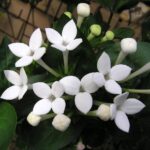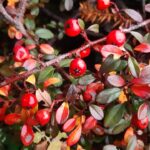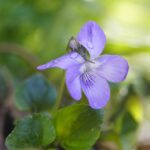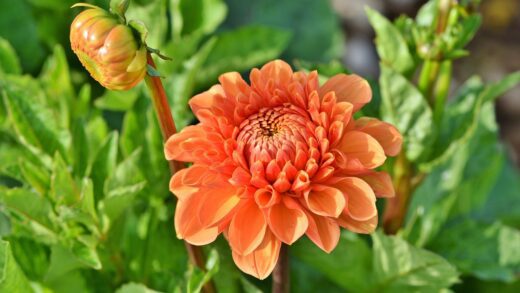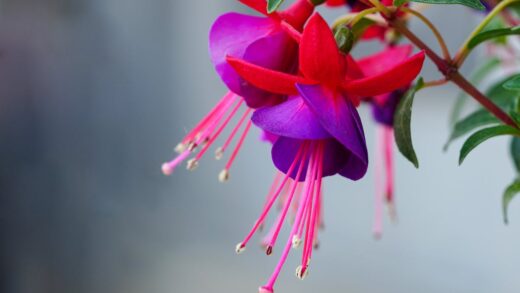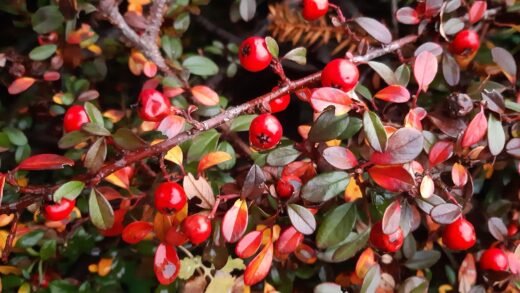While generally robust and easy to grow, coleus are not entirely immune to the pressures of diseases and pests. Proactive monitoring and good cultural practices are the most effective strategies for keeping these foliage plants healthy and vibrant. Most problems that arise are preventable and are often linked to environmental stress, such as improper watering, poor air circulation, or inadequate light. Recognizing the early signs of trouble is critical for effective management, as it allows for intervention before an infestation or infection becomes severe. A healthy, well-cared-for coleus is naturally more resilient and better equipped to fend off attacks from the common adversaries that can diminish its ornamental value.
The most significant disease threat to coleus, particularly in humid or crowded conditions, is downy mildew. This disease is caused by a water mold pathogen and manifests as yellowish or pale green spots on the upper surfaces of the leaves, often bounded by the leaf veins, creating an angular appearance. A tell-tale sign is the fuzzy, grayish or purplish mold that develops on the undersides of the leaves, especially in the morning or during periods of high humidity. Downy mildew can spread rapidly, causing severe leaf drop and potentially killing the plant if left unchecked.
Fungal root rot is another common issue, almost invariably caused by overwatering and poorly draining soil. When the soil remains saturated for extended periods, the roots are deprived of oxygen and begin to decay, creating an entry point for pathogenic fungi like Pythium and Phytophthora. The above-ground symptoms can be deceptive, often appearing as wilting, yellowing leaves, and stunted growth, which might be mistaken for underwatering. However, an inspection of the root system will reveal brown, soft, and mushy roots instead of the healthy, firm, white roots of a well-watered plant.
Among the pests, aphids are a frequent nuisance. These small, pear-shaped insects typically congregate on new growth and the undersides of leaves, using their piercing mouthparts to suck sap from the plant. A heavy infestation can cause distorted or stunted growth, yellowing leaves, and a general decline in plant vigor. Aphids also excrete a sticky substance called honeydew, which can lead to the growth of sooty mold, a black fungus that, while not directly harmful, can interfere with photosynthesis by coating the leaves.
Spider mites are another common sap-sucking pest, particularly in hot, dry conditions, making them a threat to both indoor and outdoor coleus. These tiny arachnids are difficult to see with the naked eye, but their presence is often revealed by fine webbing on the plant, especially between leaves and stems. Their feeding causes a fine, yellowish or whitish stippling on the leaves as they suck out the contents of individual plant cells. A severe infestation can cause the leaves to turn yellow or bronze and eventually drop off, significantly weakening the plant.
Common fungal diseases
Downy mildew stands out as the most destructive disease affecting coleus. Its development is highly favored by cool, damp nights and humid days. The spores are spread by wind and splashing water, and can quickly lead to a widespread outbreak in a dense planting. Prevention is the most effective control measure. This involves providing ample spacing between plants to promote good air circulation, watering the soil at the base of the plant rather than the foliage, and watering in the morning to allow leaves to dry quickly. If an infection is detected, immediately remove and destroy the affected leaves or entire plants to prevent further spread. Fungicides specifically labeled for downy mildew can be effective if applied early and regularly, but good cultural practices are the first line of defense.
Powdery mildew is another fungal disease that can affect coleus, though it is generally less damaging than downy mildew. It appears as distinctive white, powdery patches on the surfaces of leaves and stems. Like its cousin, it thrives in conditions of high humidity, particularly when days are warm and nights are cool. While it may not kill the plant, it is unsightly and can reduce the plant’s vigor by interfering with photosynthesis. Improving air circulation, reducing humidity, and ensuring the plant gets adequate light can help prevent its occurrence. Horticultural oils or neem oil can be effective in controlling minor outbreaks.
Botrytis blight, also known as gray mold, is a fungal disease that typically attacks plants under cool, humid, and stagnant conditions. It often infects stressed or damaged plant tissue, such as old flowers or dying leaves. The disease causes soft, brown, water-soaked spots on leaves, stems, and flowers, which are soon covered by a fuzzy gray or brownish mold. To manage botrytis, it is crucial to practice good garden sanitation by promptly removing any dead or decaying plant material. Improving air circulation and avoiding overhead watering, especially in the evening, are also key preventative measures.
Damping-off is a soil-borne fungal disease that primarily affects seedlings, causing them to rot at the soil line and collapse. This is a significant concern when growing coleus from seed. The fungi responsible for damping-off thrive in overly wet, cool, and poorly ventilated conditions. To prevent it, always use a sterile, well-draining seed-starting mix. Avoid overwatering by allowing the soil surface to dry slightly between waterings, and ensure good air circulation around the seedlings by removing plastic covers as soon as germination occurs and using a small fan to create gentle air movement.
Identifying and managing pests
Mealybugs are soft-bodied insects that appear as small, white, cottony masses on the stems, in leaf axils, and on the undersides of leaves. Like aphids, they feed on plant sap, leading to stunted growth and leaf yellowing. They are particularly problematic for indoor coleus during the winter. For small infestations, a cotton swab dipped in rubbing alcohol can be used to manually remove and kill the insects. For larger outbreaks, repeated applications of insecticidal soap or neem oil are necessary, ensuring thorough coverage of all plant surfaces, as mealybugs are adept at hiding in tight crevices.
Whiteflies are another sap-sucking pest that can plague coleus, especially in greenhouses or warm indoor environments. These tiny, moth-like insects will fly up in a cloud when a plant is disturbed. Both the adults and their nymph stages feed on the undersides of leaves, causing yellowing and weakening the plant. They also produce honeydew, leading to sooty mold. Yellow sticky traps are very effective at catching adult whiteflies and monitoring their population levels. Insecticidal soap or horticultural oil sprays can help control the nymph and adult stages, but repeat applications are often required to break their life cycle.
Slugs and snails can be a major problem for coleus grown in garden beds, particularly in damp, shady areas. These mollusks feed at night, chewing irregular holes in the tender leaves, which can disfigure the plant. Their presence is often confirmed by the silvery slime trails they leave behind. There are several control methods, including hand-picking them off plants after dark, setting beer traps (small containers of beer sunk into the soil), or using commercially available slug and snail baits. Creating a barrier of coarse material like crushed eggshells or diatomaceous earth around the plants can also deter them.
Thrips are tiny, slender insects that can also feed on coleus leaves, scraping the surface and sucking the sap. This feeding damage results in silvery or whitish streaks and stippling on the leaves, which can sometimes be mistaken for mite damage. They can also cause distorted growth of new leaves. Thrips are difficult to control because they are mobile and can hide in buds and leaf sheaths. Removing heavily infested leaves and treating the plant with insecticidal soap or a spinosad-based insecticide can be effective. Blue or yellow sticky traps can also help to monitor and reduce the adult population.
Preventive cultural practices
The most powerful tool against diseases and pests is maintaining strong, healthy plants through excellent cultural practices. A stressed plant is far more susceptible to attack than a vigorous one. This begins with providing the optimal growing conditions: the right amount of light for the specific cultivar, a well-draining and nutrient-rich soil, and appropriate temperatures. Avoiding extremes of any kind—too much sun, too little light, too much water, too little water—is the foundation of preventive care. A healthy plant has a robust defense system that can often ward off minor problems on its own.
Good garden sanitation is another critical preventive measure. This involves keeping the area around the plants clean and free of debris. Regularly remove any dead or yellowing leaves from the plants and the soil surface. This debris can harbor fungal spores and provide a hiding place for pests like slugs and mealybugs. At the end of the growing season, remove all annual plant material from the garden beds to reduce the amount of overwintering sites for pathogens and pests. When pruning or taking cuttings, always use clean, sterilized tools to avoid transmitting diseases from one plant to another.
Proper spacing and air circulation cannot be overemphasized, especially for preventing fungal diseases like downy mildew and botrytis. When planting coleus, give them enough room to grow to their mature size without being crowded. This allows air to flow freely through the foliage, which helps to keep the leaves dry and reduces the humidity around the plant. Similarly, for indoor plants, avoid cramming them together on a windowsill. Pruning to open up the center of a particularly dense plant can also improve air movement and light penetration.
Watering technique plays a huge role in disease prevention. As much as possible, water the soil directly and avoid wetting the foliage. Using soaker hoses or drip irrigation is ideal for this. If overhead watering is the only option, do it early in the day so the sun and wind have plenty of time to dry the leaves before nightfall. Consistently wet foliage, especially overnight, creates the perfect breeding ground for a host of fungal and bacterial pathogens. This single practice can significantly reduce the incidence of many common coleus diseases.
Treatment options
When pests are detected, the least toxic control methods should be the first choice. A strong spray of water from a hose can be surprisingly effective at dislodging pests like aphids and spider mites from the plant. This physical removal can often be enough to manage small populations. For more persistent infestations, insecticidal soaps are a good next step. These products work by disrupting the outer cell membranes of soft-bodied insects, and they are most effective with direct contact, so thorough coverage of the plant, including the undersides of leaves, is essential.
Horticultural oils, including neem oil, are another valuable tool in the gardener’s arsenal. These oils work by suffocating pests like mites, aphids, mealybugs, and whiteflies. Neem oil also has fungicidal properties and can act as an anti-feedant and growth regulator for insects. As with insecticidal soaps, these oils must be applied thoroughly to be effective and may require repeat applications. It is important to apply them in the morning or evening and not in direct, hot sun, as the oil can cause the leaves to burn (phytotoxicity).
For fungal diseases, once an infection has taken hold, chemical control may be necessary to save the plant or prevent the disease from spreading. Fungicides are most effective when used as a preventative or at the very first sign of disease. There are numerous products available, both synthetic and organic (such as those containing copper or sulfur). It is absolutely critical to correctly identify the disease in order to choose the right fungicide, and to read and follow the label instructions precisely regarding application rates and safety precautions.
In some cases, the best and most responsible course of action is to remove and destroy a heavily infested or infected plant. This is particularly true for highly contagious diseases like downy mildew or a severe, uncontrollable pest infestation. Sacrificing one plant can prevent the problem from spreading to all the other susceptible plants in the garden. This is an important part of integrated pest management (IPM), which emphasizes using a combination of cultural, biological, and chemical controls in a responsible and sustainable way.

